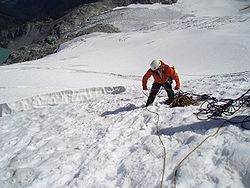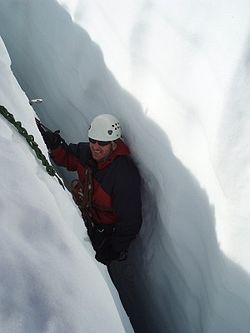
Crevasse rescue
Encyclopedia


Climbing
Climbing is the activity of using one's hands and feet to ascend a steep object. It is done both for recreation and professionally, as part of activities such as maintenance of a structure, or military operations.Climbing activities include:* Bouldering: Ascending boulders or small...
from a crevasse
Crevasse
A crevasse is a deep crack in an ice sheet rhys glacier . Crevasses form as a result of the movement and resulting stress associated with the sheer stress generated when two semi-rigid pieces above a plastic substrate have different rates of movement...
in a glacier
Glacier
A glacier is a large persistent body of ice that forms where the accumulation of snow exceeds its ablation over many years, often centuries. At least 0.1 km² in area and 50 m thick, but often much larger, a glacier slowly deforms and flows due to stresses induced by its weight...
. Because of the frequency with which climbers break through the snow over a crevasse and fall in, crevasse rescue technique is a standard part of climbing education.
The basic assumption of crevasse rescue is that two or more climbers are tied together with a climbing rope, forming a rope team; a standard number is three, one on each end and one in the middle, which means there are two available to hold a falling climber, but is not as complicated to manage as large numbers of people attached to a single rope.
When the snow gives way under the victim, the others on the team must immediately prepare for the impending yanks, usually by flopping down and digging ice axe
Ice axe
An ice axe, is a multi-purpose ice and snow tool used by mountaineers both in the ascent and descent of routes which involve frozen conditions. It can be held and employed in a number of different ways, depending on the terrain encountered...
s and knees (or boots if not wearing crampons
Crampons
Crampons are traction devices used to improve mobility on snow and ice. There are three main attachment systems for footwear: step-in, hybrid, and strap bindings. The first two require boots with welts, the last adapt to any type....
) into the snow, facing away from the crevasse if possible, and holding tight until everything stops moving. Many crevasses are small or slanted, and the fallen climber may be able to escape by digging or wiggling out; but if the climber is hanging in midair, one of several rescue techniques will need to be used.
The first step is to stabilize the situation and free up the climbers still outside the crevasse. This can be done in several ways, typically involving one person anchoring the rope with a boot-axe belay, while the other person probes for the edge of the crevasse and attempts to communicate with the victim.
- The main force technique is plausible when there are multiple rope teams; everybody simply hauls on the rope attached to the victim, drawing it over an axe shaft or other hard object so the rope friction does not cut a deep groove at the edge of the crevasse.
- The Z-pulley technique is a moderately complicated arrangement using a small moving pulleyPulleyA pulley, also called a sheave or a drum, is a mechanism composed of a wheel on an axle or shaft that may have a groove between two flanges around its circumference. A rope, cable, belt, or chain usually runs over the wheel and inside the groove, if present...
to reduce the hauling effort.
- The single-pulley technique entails dropping a pulley attached to another length of rope, which the victim clips to the climbing harnessClimbing harnessA climbing harness is a piece of equipment used in certain types of rock-climbing, abseiling or other activities requiring the use of ropes to provide access or safety...
.
- If the climber in the crevasse is able to move, he or she may be able to use prusik knots with slings or JumarJumarAn ascender is a mechanical device used for ascending on a rope. One such device is a Jumar, named after the Swiss factory which developed the first tool for sale in 1958. The device's name also leads to the term Jumaring for the process of using such a device...
s to ascend the rope. The related bilgeri technique involves the use of a second rope, and prusik knots by the rescuers instead of the victim.
Once the victim reaches the lip of the crevasse, some combination of hauling and flailing will be needed to get over it, since the victim is still suspended by the waist, with feet still in the crevasse.
Although the mechanical principle of rescue is simple, the reality is far messier. The victim may be injured and/or disoriented from the fall, the rescuers on the scene may be anxious or uncertain, equipment and ropes are scattered everywhere, and everybody will likely already be exhausted and out of breath because of the climbing and altitude. It may also be that additional crevasses are nearby, and rescuers have died in unsuspected crevasses because they unroped in order to set up a rescue of the first victim.
The experience of world-class climbers Jim Wickwire
Jim Wickwire
Jim Wickwire is a retired attorney in Seattle, Washington, most famous as the first American to reach the top of K2, the world's second-highest mountain, and then for surviving the night in the open just below the summit....
and Chris Kerrebrock on Mount McKinley
Mount McKinley
Mount McKinley or Denali in Alaska, United States is the highest mountain peak in North America and the United States, with a summit elevation of above sea level. It is the centerpiece of Denali National Park and Preserve.- Geology and features :Mount McKinley is a granitic pluton...
in 1981 shows how much can go wrong. Only a two-person team, when Kerrebrock fell in, Wickwire was pulled in after. Wickwire managed to get out of the crevasse, but Kerrebrock was jammed in the bottom, head down. Wickwire tried to pull him out, but his shoulder had been dislocated, and he didn't have the strength; Kerrebrock eventually died of hypothermia
Hypothermia
Hypothermia is a condition in which core temperature drops below the required temperature for normal metabolism and body functions which is defined as . Body temperature is usually maintained near a constant level of through biologic homeostasis or thermoregulation...
, and Wickwire had to run the gauntlet of the remaining crevasses alone.

